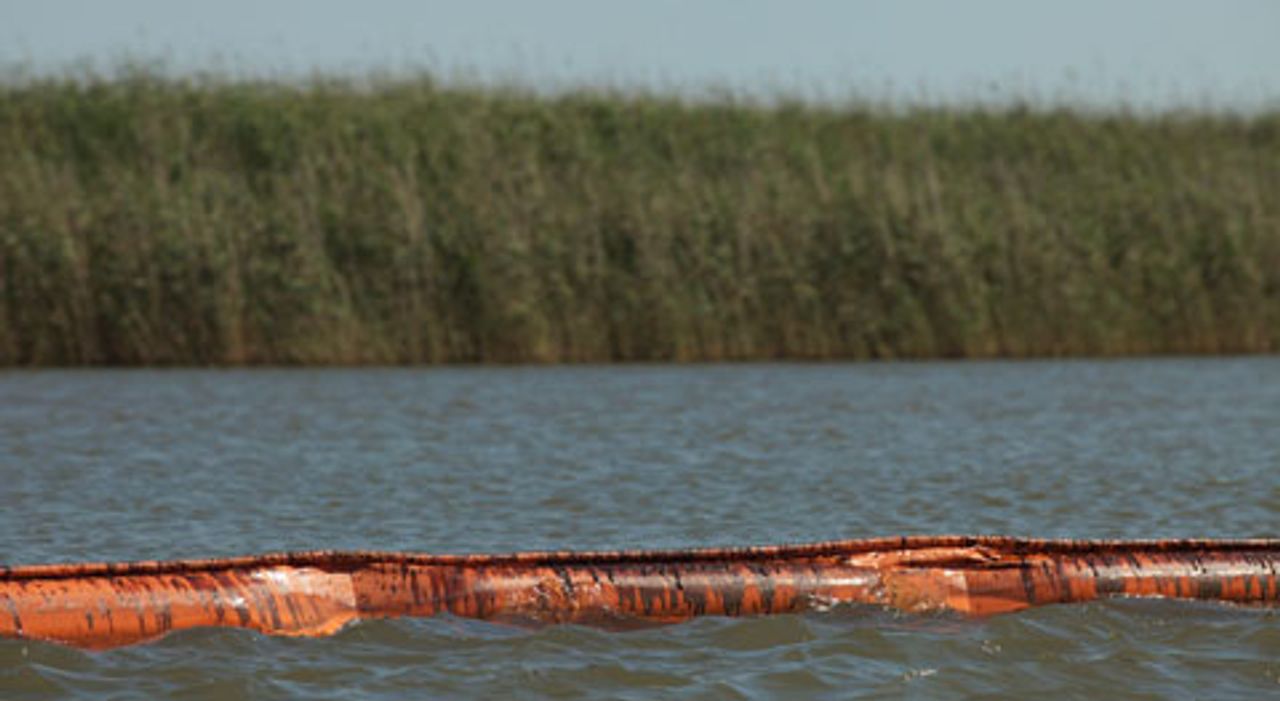The volume of oil spilled from BP’s collapsed Deepwater Horizon oil rig is likely at least ten times greater than official estimates, independent scientific analysis has revealed.
For weeks, BP, the Obama administration, its National Oceanic and Atmospheric Administration (NOAA) and the media have been claiming that 5,000 barrels of oil—or 220,000 gallons—were spilling into the Gulf of Mexico every day, even though scientists had expressed doubts about the figure.
The real figure is likely closer to 70,000 barrels, or nearly 3 million gallons, per day. If so, over 70 million gallons of oil have poured out since the April 20 explosion that killed 11 workers, about 6.5 times more already than in the Exxon Valdez oil spill, which dumped nearly 11 million gallons of crude oil into Alaska’s Prince William Sound in 1989.
 Oil booms lining the coastal wetlands near the Mississippi
Oil booms lining the coastal wetlands near the MississippiNational Public Radio (NPR) journalist Richard Harris took video footage of the spill to scientists for analysis, after BP released a tiny segment of its around-the-clock, multicamera coverage of leaking pipes on the ocean’s floor. It had refused to release any footage for weeks, citing its proprietary control over the video.
A Purdue University engineering professor, Steven Wereley, analyzed the leak using a computer method called particle image velocimetry, which is capable of discerning particles in the water and the speed at which they are moving. The scientifically-tested technique is accurate to a degree of plus or minus 20 percent, meaning that the real rate of emission could be as high as 84,000 barrels a day, over 3.5 million gallons.
These estimates are supported by two other scientists interviewed by NPR, each using a different method. Timothy Crone, a scientist with the Lamont-Doherty Earth Observatory, arrived at a minimum figure of 50,000 barrels a day. And Eugene Chiang, a professor of astrophysics at the University of California, Berkeley, estimated the spill at between 20,000 and 100,000.
It is possible that the amount pouring forth could be much higher than even these estimates, because Wereley’s calculation is based on a video of only one of the pipe’s leaks. BP claims that the footage is of the larger of two major leaks.
The World Socialist Web Site spoke with Robert Bea, a professor of engineering at the University of California, Berkeley with nearly six decades of experience in the oil industry. He said that it might be possible to determine the volume of the spill if the daily productive capacity of the well were known, but, according to Bea, “the concerned parties have put out an alert to the entire industry to ‘zip it up.’” According to Bea’s analysis, the well should produce 30,000 to 40,000 barrels per day, although the spill should be less due to constrictions in the piping.
Ever since the April 20 explosion on the Deepwater Horizon, BP and the Obama administration, with the complicity of the US media, have joined hands to minimize the scope of the disaster and suppress information that would reveal its actual dimensions.
In the first days after the explosion, BP insisted that there was no spill. When this became untenable, it admitted that there was a spill, but that it was no greater than 1,000 barrels, or 42,000 gallons, per day.
After a number of scientists and environmental groups provided much higher estimates based on satellite imagery, NOAA came up with its estimate of 5,000 barrels. BP, after first clinging to its own estimate, accepted NOAA’s calculation.
It has now been revealed that NOAA used a faulty method to calculate the spill’s size. “The figure of 5,000 barrels a day was hastily produced by government scientists in Seattle,” Justin Gillis of the New York Times reported Thursday. “It appears to have been calculated using a method that is specifically not recommended for major oil spills” known as the Bonn convention.
Alun Lewis, a British expert on the Bonn convention, cast serious doubt on NOAA’s estimate. After explaining that the method should not have been used for the Deepwater Horizon spill, Lewis said that it should not have produced an even number such as “5,000 barrels,” but a very large range of numbers. NOAA refused to reveal how they arrived at the number “nor would it address the points raised by Mr. Lewis,” the Times notes.
“The government has a responsibility to get good numbers,” commented Ian R. MacDonald, an oceanographer at Florida State University. “If it’s beyond their technical capability, the whole world is ready to help them.” MacDonald was an early critic of the NOAA number. Basing himself on satellite imagery, he calculated that the spill was at least four of five times bigger than the official estimate.
Even while the media promoted NOAA’s dubious figure, BP claimed that it was impossible to know how much oil was spilling into the ocean. As late as Thursday, BP spokesman Bill Salvin declared “there’s no way to estimate the flow coming out of the pipe accurately.” At his Rose Garden press briefing Friday, Obama argued along the same lines, referring to “a level of uncertainty.” This is nonsense.
As a number of scientists pointed out, there are in fact simple, precise, and readily available means for determining the spill’s volume. Some of these would involve placing instruments at the leaks that measures flow rate.
Richard Camilli and Andy Bowen, two scientists with the Woods Hole Oceanographic Institution who specialize in such measurements, spoke extensively with BP last week and “were poised to fly to the gulf to conduct volume measurements,” the Times reports. “But they were contacted late in the week and told not to come, at around the time BP decided to lower a large metal container to try to capture the leak. That maneuver failed. They have not been invited again.”
The spill’s volume can also be measured simply by monitoring the velocity of the spill on video footage, as the NPR report reveals. It becomes clearer why BP did not want to release the video footage. This is what marketers refer to as “controlling the message.”
Now BP and the Obama administration have fallen back on the absurd position that the size of the spill does not matter. “The estimated rate of flow would not affect either the direction or scale of our response, which is the largest in history,” a BP spokesman told the Times. “I think the [5,000 barrel] estimate at the time was, and remains, a reasonable estimate,” said Dr. Jane Lubchenco, the NOAA's administrator, appointed by Obama in 2009. “Having greater precision about the flow rate would not really help in any way. We would be doing the same things.”
 Kerry O’Neill, a charter boat captain, holds up a tarball washed up on an island in the Mississppi River delta
Kerry O’Neill, a charter boat captain, holds up a tarball washed up on an island in the Mississppi River deltaIf the Deepwater Horizon spill in the Gulf of Mexico has already far eclipsed the Exxon Valdez disaster in volume, as is almost certainly the case, the question arises as to what has become of all the oil.
A growing number of scientists and engineers are warning that the vast majority of this spill is moving around underwater. To be sure, the surface area of the spill is massive—an area estimated as about equivalent to Delaware and Rhode Island combined. Tar balls, slick, and sheen have washed ashore in an area stretching from west of the Mississippi delta to Alabama’s border with Florida.
But the real disaster could be taking place underwater and some distance out at sea, a process helped by the heavy use of highly toxic chemical dispersants. “By dispersing the stuff at depth, it creates essentially smaller globules of oil [and] it makes the oil mire likely to be affected by even slow-moving currents,” James H. Cowan Jr., a professor of oceanography and coastal sciences at Louisiana State University, told the Washington Post. “We just don’t know where it is, and we don’t know where it’s going.”
And Ronald J. Kendall, a Texas Tech University professor specializing in the impact of oil spills on the environment, told the Post that the massive use of dispersants was “a massive eco-toxicological experiment.”
Professor Bea told the WSWS about a major spill response he headed up for Royal Dutch Shell in 1970, the Bay Marchand Blowout, which took place close to the Louisiana Coast. “We used both aerial techniques and sub-sea techniques to trace where the oil was going,” Bea explained. “Half went out on the surface and half went out subsurface, and we tracked it across the continental shelf, down the continental slope, across the abyssal plain; the last place where we stopped was the Yucatan peninsula” in Mexico.
“That’s called the Gulf loop current,” Bea continued. “There’s a big current that comes right up the mouth of the Mississippi where this blowout hit. One part of it goes toward Florida, the other part goes toward Mexico.” Bea said he has seen no evidence that either BP or Transocean are concerned with this, as Shell was in an earlier period.
Bea told the WSWS that a contact had provided him with a toxicity statement for Corexit, the dispersant BP is using—so far about 500,000 gallons have been dumped on the surface and near the seabed, and about 800,000 more gallons are on order. “It clearly says, if you breathe too much of it or if you ingest too much of it, if you let too much sit on your skin, it’ll kill you,” Bea said. “And of course I’m sitting here thinking if I’m a fish, I don’t know that.”
A Thursday report in the New York Times, “Less Toxic Dispersants Lose Out in BP Oil Spill Cleanup,” reveals that Corexit is one of the most highly toxic dispersants on the market, and one of the least effective.
“Of 18 dispersants whose use EPA has approved, 12 were found to be more effective on southern Louisiana crude than Corexit, EPA data show,” according to Paul Quinlan of the Times’ Greenwire blog. “Two of the 12 were found to be 100 percent effective on Gulf of Mexico crude, while the two Corexit products rated 56 percent and 63 percent effective, respectively. The toxicity of the 12 was shown to be either comparable to the Corexit line or, in some cases, 10 or 20 times less, according to EPA.”
So why is it being used? Once again, the most immediate profit concerns predominate. Corexit is produced by Nalco Co., a firm headed up by executives from both BP and industry leader Exxon. “It’s a chemical that the oil industry makes to sell to itself, basically,” said Richard Charter of Defenders of Wildlife.
“I’m wondering if they understand the impact of these dispersants that we now put down close to the sea floor,” Bea said. “You might not get tar on your feet walking on the beach. But the blue fin tuna that spawn right in this area are going to catch hell.”
